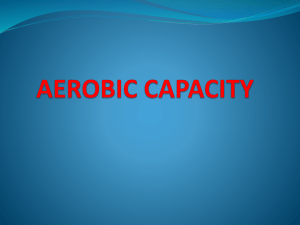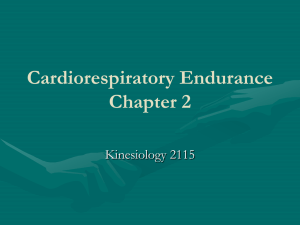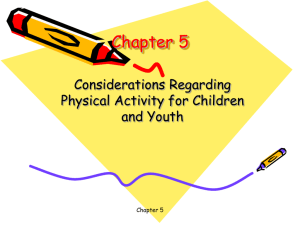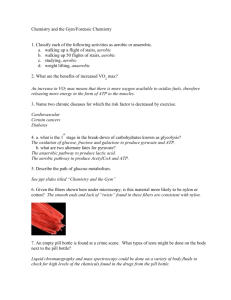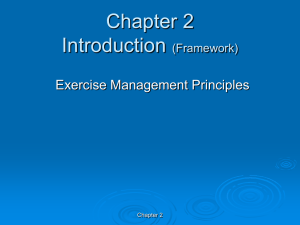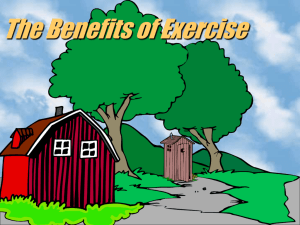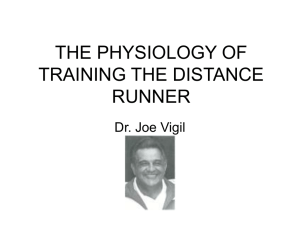7. Components of fitness
advertisement
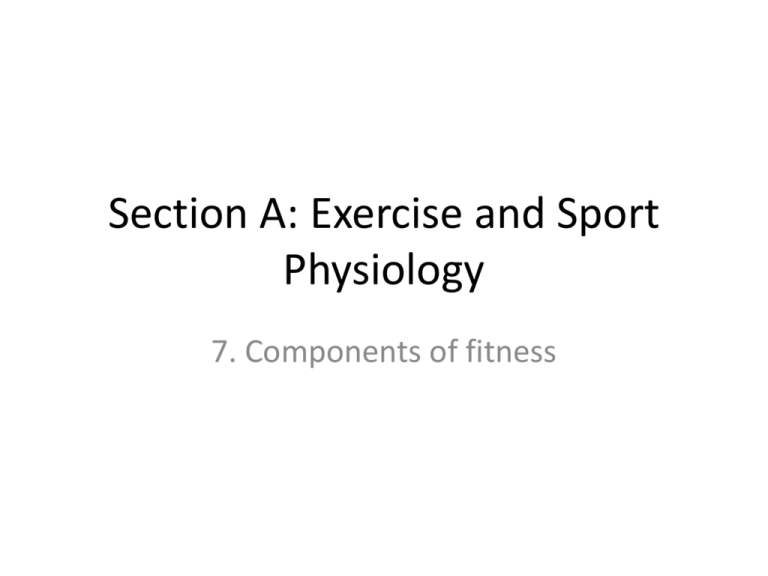
Section A: Exercise and Sport Physiology 7. Components of fitness Syllabus • • • • • • • • • Aerobic capacity Strength Flexibility Body composition Balance Co-ordination Agility Reaction time Speed Strength • Strength describes the application of a force against a resistance. • There are 5 different types of strength each with their own method of evaluation. 1: Maximum Strength • Definition – The maximum force exerted in one single voluntary contraction • Evaluation – 1RM – Leg/grip dynamometer 2: Static Strength • Definition – The force exerted by the neuromuscular system while the muscle length remains constant. – It is termed an isometric muscle contraction. • Evaluation – No single or generic test. – Strength varies and is specific to the joint. 3: Explosive/Elastic Strength • Definition – The ability to expend a maximal amount of energy in one or a series of strong, sudden high intensity movements. • Evaluation – Vertical jump test (leg strength) 4: Dynamic Strength • Definition – The functional application of strength and speed which represents “power” – Strength (force times distance) – Speed (divided by time) • Evaluation – Wingate cycle test – RAST 5: Endurance Strength • Definition – The ability of a muscle to sustain or withstand repeated muscle contractions. • Evaluation – NCF abdominal sit-up test – Push-up test Factors Affecting Strength • Muscle composition • Gender • Age • Physical inactivity • Strength training • Joint angle Muscle Composition • The greater the: – Percentage of fast twitch muscle fibres – Cross-sectional area of muscle – Muscle size the greater the potential force that can be generated or applied. Gender • Female strength is generally lower than males because: – Females generally have less muscle mass, crosssectional area and muscle size – Females have less testosterone than males Age • Female peak strength is reached (16-25yrs) • Male peak strength is reached (18-30yrs) • Greatest gains are made between the age of 20 and 30yrs for males and females (testosterone levels peak) • Strength decreases with age due to decrease in testosterone (less muscle mass) Physical Inactivity • Atrophy (decrease in muscle size) starts after approximately 48hrs of inactivity and induces the loss of muscle strength already gained from training. • Look at your notes on reversibility Joint Angle • The weakest point in the range of motion specific to the relative angle of a given joint Energy System during Strength Training Type Strength Adaptations • Effects of strength training are largely confined to muscle adaptations. • Early improvements in strength are reported without any increase in muscle hypertrophy which can take 2 to 3 weeks to adapt. • Improvements depend on the starting level of strength. Flexibility • Definition: the range of motion around a joint or a series of joints. • Flexibility is then obviously joint specific. • Flexibility is also sport specific. • 2 components: static and dynamic flexibility Components of Flexibility • Static flexibility is a pre-requisite to dynamic flexibility. • It does not ensure it however. • In regards to specificity: – Static flexibility is important to dancers and gymnasts (no account for speed) – Dynamic flexibility is important in high-velocity movements Difference between Flexibility and Stretching • Flexibility is the range of movement (RoM) • Stretching is the training method used to increase flexibility Benefits of Flexibility Training • Reduced risk of injury • Improved posture • Reduction of DOMS • Performance enhancement: – Muscles perform better – Improves RoM allowing more force – Improves economy of movement Type of Flexibility Training • Static • Ballistic • Dynamic • Proprioceptive Neuromuscular Facilitation Static • Current research suggests this type of stretching is most effective at the END of a session • Help muscle relaxation using – Maintenance stretches to return muscles to their pre-exercise length – Developmental stretches to increase RoM Ballistic • Thought to be least effective • Fails to allow adequate time for the tissues to adapt to the stretch • Creates muscle tension which makes it more difficult to stretch connective tissues • Should only be performed by athletes who already have a good RoM Dynamic • More appropriate for a warm up than static stretches to increase subsequent speed, power, and strength work • Should only be performed by athletes who already have a good range of flexibility PNF • More appropriate in muscles/connective tissue around joints with POOR RoM • Seeks to inhibit this stretch reflex to allow a greater stretch of tissues • Shown to produce quicker and equal or better flexibility gains than static stretching Flexibility Training Benefits • Increased elasticity/length of muscle/connective tissues • Muscle spindles adapt to increased length reducing stimulus to the stretch reflex • Increased distance and efficiency for muscles to create force and acceleration • Reduces potential for injury • Appropriate posture (pelvic girdle) Body Composition • Refers to the chemical make up of the body • It is split into two components: – Fat mass: percentage of body weight that is stored as fat – Lean body mass: the weight of the rest of the body (non-fat tissues) – Muscle mass weighs three times more than fat per unit volume Size and Body Composition in relation to Sport • Ideal size for an athlete depends on the sport or event and the position they play in their sport • Body composition is of greater concern than size and build • Body composition tends to concentrate more on percentage of fat tissue than lean body mass Body Mass Index (BMI) • Weight in kilograms divided by height in metres squared • Does not directly measure body fat • Not suitable for – young children, pregnant women, the elderly or athletes REMINDER • NEED TO GIVE YOU GUYS 2 HANDOUTS ON COMPOSITION ASSESSMENT AND BMI TABLE VALUES Overweight and Obesity • Occur as a result of an imbalance between energy intake and energy expenditure Energy Expenditure • To understand how to influence the balance between energy intake and expenditure you need to know • Basal metabolic rate • Energy measurement (METS) • Calorific intake Basal Metabolic Rate (BMR) • BMR is the lowest rate of energy expenditure needed to sustain the body’s essential physiological functions while at rest • RMR (resting metabolic rate) is more often used, to avoid the need to measure sleep • Body’s daily energy expenditure: – RMR accounts for 60-75% – Physical activity accounts for 20-30% – Eating, digesting etc accounts for the rest. BMR/RMR Calculation • Adult males: – Multiply body weight by 10, add double the body weight to this value – 150lb male – 150 times 10 + 300 = 1800cal/day • Adult females: – Multiply body weight by 10, add the body weight to this value – 150lb female – 150 times 10 + 150 = 1650cal/day Metabolic Equivalent Task (METs) • METs use oxygen consumption per unit of body weight per minute (mlO2/kg/min) to estimate exercise intensity • Oxygen consumption is directly proportional to energy expenditure during activity • At rest your body uses approx. 3,5mlO2 per kg of body weight per min. • 3,5ml/kg/min = 1 MET = resting volume of O2 consumed (VO2) Caloric Energy Expenditure • 3,5ml/kg/min = 0.0175kcal/kg/min • You can estimate the number of calories you use while participating in physical activity • Factor in METs, body weight and time Caloric Energy Expenditure Example • 150lb = 68.1kg (1lb = 0.454kg) • 8METs × 0.0175 = 0.14kcal/kg/min (1MET = 0.0175kcal/kg/min) • 0.14 × 68.1 = 9.534kcal/min • 9.534 × 60 = 572.04kcal (full duration) An Alternative Equation • Total calories burned = (METs × 3.5 × weight in kg) ÷ 200 × duration in min = 8.0 × 3.5 × 68.1 = 1906.8 ÷ 200 = 9.534kcal/min × 60min = 572.04kcal/hr Performance Implications of Body Weight • Successful performers – low body fat (due to energy expenditure) • Low fat mass is more significant in aerobic endurance activities. Any weight not DIRECTLY linked to metabolism has to be carried for longer, wasting energy! • Fat mass reduces the power-to-weight ratio (acceleration is inversely proportional to mass) Agility • The ability to move and change direction and position of the body quickly and effectively while under control • Methods of evaluation – – – – – – – 505 Agility Test Illinois agility run test 'L' Test Lateral Change of Direction test Quick Feet test Shuttle Run Test 'T' Drill test 505 Agility Test Illinois Agility Test Balance • The maintenance of the centre of mass over the base of support • Static balance is maintaining equilibrium when stationary • Dynamic balance is maintaining equilibrium when moving • Methods of evaluation – Standing stork test (blind) Co-ordination • Coordination is the ability to move two or more body parts under control, smoothly and efficiently • Method of evaluation – Throw a ball (right hand) against a wall and catch it (left hand) Speed • The maximum rate that a person can travel over a specific distance, and also how quickly a person can put body parts into action • Method of evaluation (depends on event) – 30m acceleration test – 40m multiple sprint test – 300yrd shuttle test Reaction Time • The interval time between the onset of a stimulus and the initiation of the muscular response • If there is only one possible response (simple reaction time) • If there are several possible responses (choice reaction time) • Reaction time increases proportionally to the number of possible responses until a point at which the response time remains constant despite the increases in possible responses (Hick's Law). Factors Affecting Reaction Time • • • • • • Age Gender Intensity of stimulus Previous experience Arousal levels Stimulus-response compatibility • Time taken can be reduced through practice and anticipation Aerobic Capacity VO2 Max Aerobic Capacity • …is the ability to take in, transport and use oxygen to sustain prolonged periods of aerobic/sub-maximal work. Aerobic Capacity & Body Systems • Aerobic capacity is dependent upon the efficiency of four body systems: – Respiratory system to consume oxygen – Heart to transport oxygen – Vascular system to transport oxygen – Muscles cells to use oxygen VO2 Max • …is the highest rate of oxygen consumption attainable during maximal/exhaustive work. • VO2 max mean values: • 20yr Male – 40ml/kg/min (for mass of 87.5kg) • 20yr Female – 35ml/kg/min (for mass of 66kg) • Endurance athletes – 75ml/kg/min (for mass of 66kg) VO2 Max • Sedentary performer = up to 3 or 4 litres of oxygen per minute – Anaerobic threshold is typically about 50/60% of VO2 max • Elite distance runner = up to 6 or 7 litres of oxygen per minute – Anaerobic threshold may be above 85% of VO2 max VO2 Max • A higher anaerobic threshold or OBLA is a good indicator of aerobic performance • Those who are fit have higher VO2max values and can exercise more intensely than those who are not as well conditioned. Factors Affecting VO2 Max • Hereditary • Specificity of training • Age • Gender Hereditary • Can account for as much as half the variation in VO2 max, e.g. whether an athlete has a higher percentage of Type 1 and Type 2a (FOG) • An athlete’s individual response to training varies because of genetic variation • Hereditary only indicates an individual’s POTENTIAL to have a high VO2 max – this is dependent on aerobic training Specificity of Training • VO2 max will increase due to long term adaptations to aerobic training • Links directly to an athlete’s individual response to training • The more specific the training to the sport performed and the athlete’s needs, the greater the potential improvement Age • VO2 max decreases approx. 1% per year due to a decrease in the efficiency of the body systems – Dependent on activity levels! • The age at which VO2 max starts to decrease varies with the level of adaptation/training and the individual’s response to training • It is thought to have 2 main causes – Cardiovascular – decreased ventricular elasticity – Respiratory – decreased elasticity of lung tissue Gender • VO2 max values for women are generally 20-25% lower than those for men • Women are disadvantaged by having greater percentage of body fat, since this decreases VO2 max when measured per kilogram of body mass • A smaller body size means: – Smaller lung volume (decreases external respiration) – Smaller heart lowers SV and CO at maximal rates of work – Lower Hb levels Measurement of VO2 max • PWC 170 Test • Multi-stage Fitness Test (MSFT) • Both are indirect tests which estimate a VO2 max value PWC 170 Test • Sub-maximal test on a cycle ergometer • Performer cycles at – 100-115bpm / 115-130bpm / 130-145bpm • As HR increases linearly with work intensity a line can be drawn to make a prediction Measuring VO2 max using Gas Analysis • Most valid and accurate DIRECT measurement • Measures and compares the amount of oxygen inspired and expired as work intensity is progressively increased, either on a raised treadmill or cycle ergometer, until a near exhaustion state is reached Multi-Stage Fitness Test • A progressive and maximal 20m shuttle run test • It is timed by a bleep which progressively becomes shorter until the athlete cannot keep up • The level and shuttle number score is then compared with standardised tables to estimate VO2 max Aerobic Training • To develop aerobic capacity you will need knowledge of three types of training – Continuous – Fartlek – Interval (repetition) Aerobic Training • Irrespective of type of training being used it is essential that you measure the intensity of training to ensure the performer is training within the “training zone” • Target heart rates are used as an intensity guide for training as it is more practical than using VO2 max Aerobic Training • Numerous studies show that you can increase your VO2max by working out at an intensity that raises your heart rate to between 65 and 85% of its maximum for at least 20 minutes three to five times a week (referenced in French & Long: 2012) Aerobic Training TRAINING ZONES (PERCENT) TRAINING OBJECTIVES 60 Fat burning / re-energise glycogen stores 70 Develop oxygen transportation 80 Improve lactic acid threshold 85 Lactic threshold 90+ Speed Aerobic Training Methods • Involves whole-body activities like running, cycling, rowing and swimming • It is aimed at overloading the cardiovascular and respiratory systems • Why? • To increase the aerobic capacity/VO2 max Aerobic Training Methods • Overload is achieved by applying the FITT principle specifically to aerobic capacity • F = minimum of 3-5 times a week for a minimum of 12 weeks • I = heart rate training zone as indicator • T = minimum of 5min to 40+ min (elite) • T = overloading the aerobic energy systems Continuous Training • Steady state sub-maximal work for prolonged periods (20-30 minutes plus) • More suited long distance/endurance athletes • HR should be above the critical threshold Fartlek Training • Otherwise known as speed play training • It is a mixture of continuous and interval training that adds variation of higher intensity work • Mixture of sprints or any exercises that intersperse the steady state work • It will overload both the aerobic and anaerobic systems • Ideal for games whose matches are never exactly the same intensity, to improve their VO2 max and recovery process Interval Training (Repetition) • Consists of periods of work interspersed with periods of relief (recovery) • Has four components: – Interval duration – Interval intensity – Recovery/relief duration – Number of work-relief intervals Energy System and Food Fuels during Aerobic Work • Involves the 3 stages of the aerobic system – Aerobic glycolysis – Kreb’s cycle – Electron Transport Chain • Summary of food fuels used during aerobic work – Glyocogen/glucose major fuel for first 20-40min – Greater breakdown of fats ALONGSIDE glycogen as fuel occurs after 20-45min – As duration increases there is a greater mix of glycogen and fats – When glycogen stores become almost fully depleted (+2hrs) FFA’s are used
